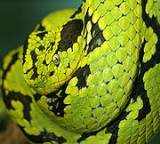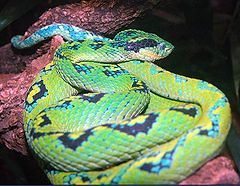
Bothriechis aurifer
Encyclopedia
- Common names: yellow-blotched palm-pitviper, Guatemalan palm viper.
Bothriechis aurifer is a venomous
Venomous snake
"Poisonous snake" redirects here. For true poisonous snakes, see Rhabdophis.Venomous snakes are snakes which have venom glands and specialized teeth for the injection of venom...
pitviper
Crotalinae
The Crotalinae, commonly known as "pit vipers" or crotaline snakes, are a subfamily of venomous vipers found in Asia and the Americas. They are distinguished by the presence of a heat-sensing pit organ located between the eye and the nostril on either side of the head...
species
Species
In biology, a species is one of the basic units of biological classification and a taxonomic rank. A species is often defined as a group of organisms capable of interbreeding and producing fertile offspring. While in many cases this definition is adequate, more precise or differing measures are...
found in Mexico
Mexico
The United Mexican States , commonly known as Mexico , is a federal constitutional republic in North America. It is bordered on the north by the United States; on the south and west by the Pacific Ocean; on the southeast by Guatemala, Belize, and the Caribbean Sea; and on the east by the Gulf of...
and Guatemala
Guatemala
Guatemala is a country in Central America bordered by Mexico to the north and west, the Pacific Ocean to the southwest, Belize to the northeast, the Caribbean to the east, and Honduras and El Salvador to the southeast...
. No subspecies
Subspecies
Subspecies in biological classification, is either a taxonomic rank subordinate to species, ora taxonomic unit in that rank . A subspecies cannot be recognized in isolation: a species will either be recognized as having no subspecies at all or two or more, never just one...
are currently recognized.
Description

The scalation includes 1-5 intersupraocular scales, 8-12 supralabials, 9-13 infralabials and 18-21 (mode 19) rows of dorsal scales
Dorsal scales
In snakes, the dorsal scales are the longitudinal series of plates that encircle the body, but do not include the ventral scales.When counting dorsal scales, numbers are often given for three points along the body, for example 19:21:17...
at midbody. The second supralabial is fused with the prelacunal to form a lacunolabial and the interrictals number 16-21. Males have 148-167 ventral scales
Ventral scales
In snakes, the ventral scales are the enlarged and transversely elongated scales that extend down the underside of the body from the neck to the anal scale. When counting them, the first is the anteriormost ventral scale that contacts the paraventral row of dorsal scales on either side...
and 58-64 subcaudals (mostly undivided), while females have 152-162 ventrals and 48-61 subcaudal scales.
The color pattern consists of a green ground color overlaid dorsally with a series of yellow blotches that are bordered in black. Between the botches, an irregular, often broken, dorsal stripe can be seen. The yellowish green belly is often lighter than the dorsum. On the head, a dark postocular stripe is present. The iris is usually yellowish-green, sometimes bronze, with black specks or reticulations. Over 90% of all specimens have the usual dark dorsal pattern, but a few are uniform green and have no postocular stripes. The juvenile coloration includes a pale lime green ground color and a colorful tail tip.
Geographic range
Found in MexicoMexico
The United Mexican States , commonly known as Mexico , is a federal constitutional republic in North America. It is bordered on the north by the United States; on the south and west by the Pacific Ocean; on the southeast by Guatemala, Belize, and the Caribbean Sea; and on the east by the Gulf of...
in the mountains of eastern Chiapas
Chiapas
Chiapas officially Estado Libre y Soberano de Chiapas is one of the 31 states that, with the Federal District, comprise the 32 Federal Entities of Mexico. It is divided in 118 municipalities and its capital city is Tuxtla Gutierrez. Other important cites in Chiapas include San Cristóbal de las...
, and in northern Guatemala
Guatemala
Guatemala is a country in Central America bordered by Mexico to the north and west, the Pacific Ocean to the southwest, Belize to the northeast, the Caribbean to the east, and Honduras and El Salvador to the southeast...
. Occurs in cloud forest at 1200-2300 m altitude. The type locality given is "Cobán, [Alta] Vera Paz, Guatemala."
Conservation status
This species is classified as Vulnerable (VU) on the IUCNWorld Conservation Union
The International Union for Conservation of Nature and Natural Resources is an international organization dedicated to finding "pragmatic solutions to our most pressing environment and development challenges." The organization publishes the IUCN Red List, compiling information from a network of...
Red List of Threatened Species
IUCN Red List
The IUCN Red List of Threatened Species , founded in 1963, is the world's most comprehensive inventory of the global conservation status of biological species. The International Union for Conservation of Nature is the world's main authority on the conservation status of species...
with the following criteria: B1ab(iii,v) (v3.1, 2001). A species is listed as such when the best available evidence indicates that the extent of occurrence is estimated to be less than 20,000 km², the population to be severely fragmented or known to exist at no more than 10 locations, and that a continuing decline has been observed, inferred or projected in the area, extent and/or quality of habitat and in the number of mature individuals. It is therefore considered to be facing a high risk of extinction in the wild. The population trend is down. Year assessed: 2007.

